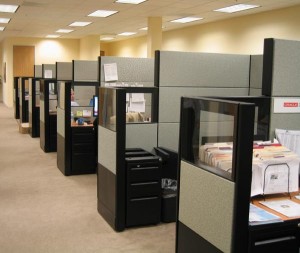“Human beings were not meant to sit in little cubicles staring at computer screens all day, filling out useless forms and listening to eight different bosses drone on about mission statements.” — Peter Gibbons in the movie Office Space, as portrayed by actor Ron Livingston.
 Most modern offices consist of open-format workspaces designed to encourage collaboration and sociability. This sounds reasonable enough…until you remember two inconvenient facts. First, external distractions tend to limit worker productivity, and second, open offices provide a constant stream of distractions.
Most modern offices consist of open-format workspaces designed to encourage collaboration and sociability. This sounds reasonable enough…until you remember two inconvenient facts. First, external distractions tend to limit worker productivity, and second, open offices provide a constant stream of distractions.
Nevertheless, businesses often put office-workers on display in cubicle mazes, overseen by a few managers in private offices. Walls (if they exist at all) rise just high enough to provide an illusion of privacy, as long as you’re sitting down. These walls come equipped with padding, supposedly to provide soundproofing. However, since the cubicles lack roofs and doors, it usually doesn’t work very well.
All this openness may seem wonderful to chatty extroverts, but a high percentage of us (some studies suggest as many as half) are more inward-centered. For introverts, open-format offices and high productivity just don’t mix.
Most people give in to the majority and learn to adapt—somewhat. They do fairly well by adopting actions that “distract the distractions,” if you will, such as listening to ambient sound and wearing noise-reducing earphones. But just because they’ve adapted doesn’t mean they achieve peak performance on a regular basis.
A Few Alternatives
Rather than just assume the majority should rule, smart office designers and managers provide opportunities for reclusive team members to find the solitude they need to work undisturbed. Similarly, workplace architects have begun to recognize the need to provide spaces for both people seeking to be around others and those seeking to hide from them.
Still, breaking out of the cube has proven somewhat difficult for companies used to wide-open spaces. No culture changes overnight—organizations have their own unique cultures, just as tribal societies and high-tech civilizations do. But even in a traditional “cube farm,” a few simple changes can work wonders.
Get everyone cubicle doors, which give workers an illusion of privacy. A number of companies provide these accessories nowadays, and you can install them easily enough. Once in place, occupants can close the door and add a “Do Not Disturb” sign when they really need to concentrate. While cubicle doors won’t completely block surrounding noise, they can prevent distraction from movement in the corridor outside and keep co-workers from popping in unannounced.
The best solution would involve providing solitude-seekers with individual offices, but that won’t work in many workplaces (if only because everyone would want one). A more practical solution is to provide small-group workrooms where those seeking concentration and/or teams of three or fewer can retreat when necessary. If no such facilities exist, open conference rooms can take their place.
A More Radical Departure
Aside from last-ditch escape locales like public libraries and coffee shops, arguably the best remaining alternative for workplace solitude is telecommuting. Millions of people already work from their homes at least one day a week. This provides the option of allowing “lone geniuses” to create workspaces in known comfort zones where they don’t have to deal with most of the distractions of the typical office. Sure, they have to prove they can produce, but that’s why we have probationary periods. Telecommuters also have to remain accessible at all times during office hours and occasionally have to appear in person at office meetings, so they’ll have to adapt to those realities if they want to maintain the isolation they need to maximize personal productivity.
The Bottom Line
Maximum productivity, whether on an individual, team, or company-wide basis, requires flexibility all around. When it comes to fully integrating the quiet-seekers into the workplace, however, a positive management response may be most important. If you hold a management position, think about how you might better enable concentration. At minimum, you could set aside a few special workspaces. Ultimately, you could intervene in the corporate culture to reinforce quiet spaces as productivity resources.
If you yourself work best in a less open environment, let your manager know, so you can try to negotiate a workable solution. If leadership proves unable or unwilling to help you max out your productivity at work, do your best to meet them halfway. Adapt as well as you can, even if you have to break completely out of your cube sometimes and closet yourself away to get your best work done.



[…] pro Laura Stack argues that while open plan offices are built to encourage worker interaction and increase […]